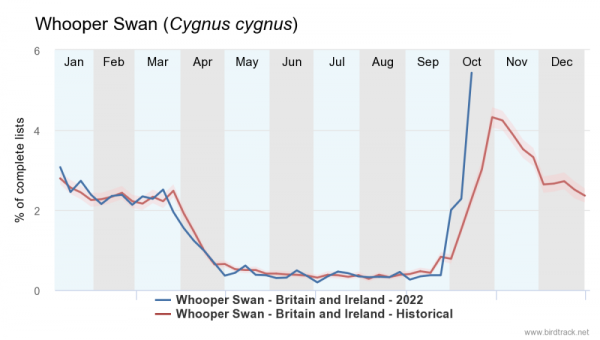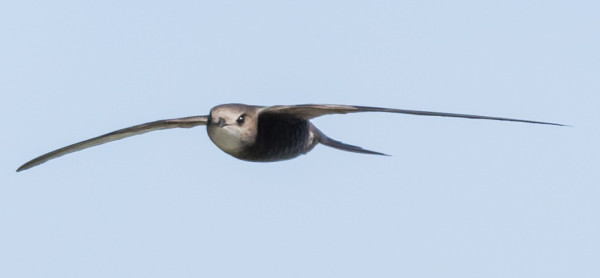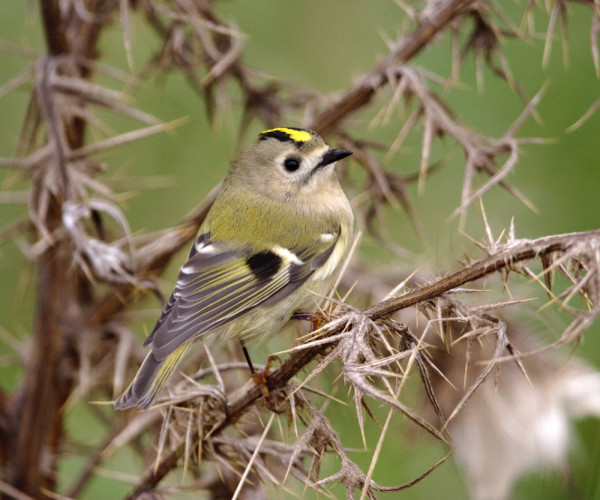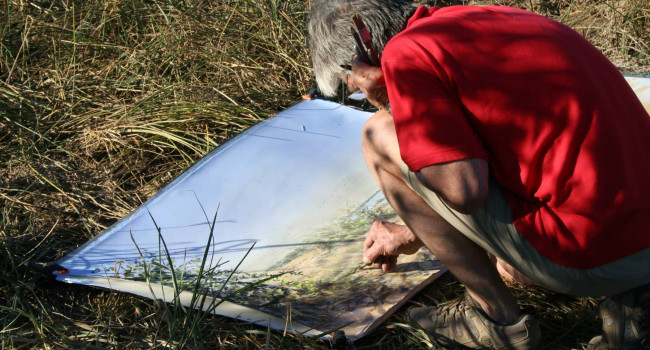
BirdTrack Migration Blog (14th - 20th October)
Scott’s role includes the day-to-day running of BirdTrack: updating the application, assisting county recorders by checking records and corresponding with observers.
Relates to projects
Whilst the intensity of migration may have waned slightly, the mix of species recorded in the last week remained high.
A late autumn pulse of House Martins was an interesting record; presumably, these birds were passing through from Northern Europe. A large number of these were juvenile birds, indicating this species has had a successful breeding season.
The first scattering of Fieldfares hinted at what is to come. More birds are likely to arrive in the next couple of weeks, slightly later than the Redwings which continued to be widely reported.
Another species typically seen in good numbers at this time of year is Skylark. The last couple of weeks have seen reports continuing to build as birds gather in flocks for the winter ahead. These often associate with other species such as Meadow Pipit, and you may be lucky enough to find a Lapland Bunting mixed in with them.

Wildfowl continued to arrive, but due to the lack of easterly winds reports were down for many species compared to last week. Pink-footed Geese, however, continue to be well reported as a spell of north-westerlies aided their arrival from Iceland. These same weather conditions will have helped Whooper Swans along their migration; birds are arriving around a week or so earlier than what is normally expected.
A Least Bittern in Shetland was a British first, and was a highlight for those lucky to see it. The bird was taken into care soon after it was found, as it was very underweight - often the case with trans-Atlantic vagrants such as this, which are not adapted to such lengthy journeys over open water. Sadly, the bird died overnight, exhausted from its non-stop ocean crossing.
Other rarities seen during that last week included a Blackburnian Warbler in Isles of Scilly, Tennesse Warbler in Pembrokshire, Yellow-browed Bunting in Kent, Baltimore Oriole in Devon, and an Alder Flycatcher in Galway.
In the coming week, a look out to sea during a light onshore breeze could see a veritable feast of birds arriving from the continent.
Looking ahead

The weekend forecast is dominated by a low-pressure system sitting in the Atlantic, drawing in winds from Iceland, Greenland, and North America. These winds will be coupled with showers across most of Britain and Ireland, and will result in a slowing in migration. However, those on the west coast will no doubt be on the lookout for more American waifs such as Sora, Northern Waterthrush, or maybe Scarlet Tanager - the Isles of Scillies and the west coast of Ireland will be the best places to find these birds should they arrive.
As this low-pressure system moves east into Scotland on Sunday, the winds switch to a more north-westerly direction. This could see Whooper Swan, Pink-footed Geese, and Redwing arriving along the western coasts of Scotland. In contrast, the southern half of Britain will see winds coming up from Western Europe, which could bring species such as Pallid Swift or Red-rumped Swallow with them.

As we progress towards the middle of the week, high pressure building over Scotland will draw in winds from the east. These are always welcomed at this time of year: the pulse of migrants they can bring has the possibility of including something rare.
The most likely species to arrive are Goldcrest and Starling, while thrushes, finches, and wildfowl could also be well represented. Indeed, a look out to sea during a light onshore breeze could see a veritable feast of birds arriving from the continent, everything from Dark-Bellied Brent Geese, to Long-eared Owls to flocks of Skylarks.
Scarce birds to look out for include Dusky and Radde's Warbler, Olive-backed Pipit, Red-flanked Bluetail, and Siberian Stonechat. I am sure many will still be hoping for a twitchable Siberian Rubythroat…we can but dream.









Share this page